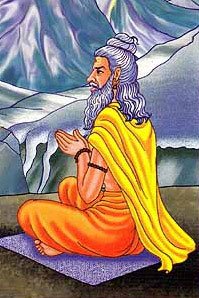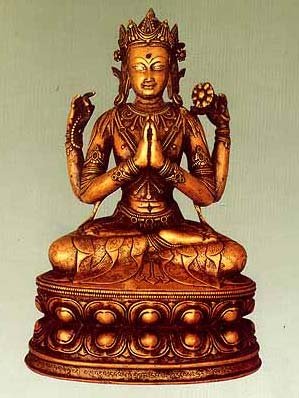Mahashura, Mahasura, Maha-asura, Mahāśūra, Mahaśūra: 9 definitions
Introduction:
Mahashura means something in Buddhism, Pali, Hinduism, Sanskrit, Jainism, Prakrit, Marathi. If you want to know the exact meaning, history, etymology or English translation of this term then check out the descriptions on this page. Add your comment or reference to a book if you want to contribute to this summary article.
The Sanskrit terms Mahāśūra and Mahaśūra can be transliterated into English as Mahasura or Mahashura, using the IAST transliteration scheme (?).
In Hinduism
Purana and Itihasa (epic history)
Source: archive.org: Puranic EncyclopediaMahāśūra (महाशूर).—One of the Asura leaders who fought against Subrahmaṇya. (Skanda Purāṇa, Asura Kāṇḍa).
Source: archive.org: Shiva Purana - English TranslationMahāsura (महासुर) (Cf. Mahadaitya) refers to a “great demon” and is used to describe Tāraka, according to the Śivapurāṇa 2.3.15 (“The penance and reign of Tārakāsura”).—Accordingly, as Brahmā narrated: “Then all those gods and sages consulted one another and in their great fright they came to my world and approached me in a piteous plight. [...] Coming to a definite conclusion with adequate thought as to the reason for the same, I went where the demon was performing penance in order to grant him the boon. O sage, I told him thus—‘Tell me what boon you want. A severe penance has been performed by you. There is nothing which cannot be granted to you’. On hearing these words of mine, Tāraka, the great demon [i.e., mahāsura], bowed and eulogised me and requested for a terrible boon”.

The Purana (पुराण, purāṇas) refers to Sanskrit literature preserving ancient India’s vast cultural history, including historical legends, religious ceremonies, various arts and sciences. The eighteen mahapuranas total over 400,000 shlokas (metrical couplets) and date to at least several centuries BCE.
In Buddhism
Mahayana (major branch of Buddhism)
Source: Wisdom Library: Maha Prajnaparamita SastraMahāśūra (महाशूर) refers to “heroic (strength)”, according to Mahāprajñāpāramitāśāstra (chapter 19).—Accordingly, “Furthermore, some say that generosity is the cause and condition (hetupratyaya) for obtaining the thirty-two marks. Why is that? [...] By giving with heroic strength (mahāśūra-bala), one obtains the mark consisting of having a broad heel (āyatapādapārṣṇi). [...]”.

Mahayana (महायान, mahāyāna) is a major branch of Buddhism focusing on the path of a Bodhisattva (spiritual aspirants/ enlightened beings). Extant literature is vast and primarely composed in the Sanskrit language. There are many sūtras of which some of the earliest are the various Prajñāpāramitā sūtras.
In Jainism
General definition (in Jainism)
Source: archive.org: TrisastisalakapurusacaritraMahāśūra (महाशूर) refers to one of the ten sons of Vasu, the son of Abhicandra (an ancient king from Śaktimatī), according , according to the Jain Ramayana and chapter 7.2 [Rāvaṇa’s expedition of conquest] of Hemacandra’s 11th century Triṣaṣṭiśalākāpuruṣacaritra: an ancient Sanskrit epic poem narrating the history and legends of sixty-three illustrious persons in Jainism.
Accordingly, as Muni Nārada said to Rāvaṇa: “[...] Then King Vasu, destroyed by the gods who were angered by that falsehood, went to a terrible hell. Vasu’s sons, Pṛthuvasa, Citravasu, Vāsava, Śakra, Vibhāvasu, Viśvāvasu, and the seventh, Śūra, and the eighth, Mahāśūra, seated at their father’s feet, were killed by the gods at that time from anger. The ninth son, Suvasu, fled to Nāgapura and Vasu’s tenth son, Bṛhaddhvaja went to Mathurā. Much ridiculed by the citizens, Parvata was banished from the city and was received by the Asura Mahākāla”.

Jainism is an Indian religion of Dharma whose doctrine revolves around harmlessness (ahimsa) towards every living being. The two major branches (Digambara and Svetambara) of Jainism stimulate self-control (or, shramana, ‘self-reliance’) and spiritual development through a path of peace for the soul to progess to the ultimate goal.
Languages of India and abroad
Marathi-English dictionary
Source: DDSA: The Molesworth Marathi and English Dictionarymahaśūra (महशूर).—a ( A) Notorious, celebrated, publicly known.
Source: DDSA: The Aryabhusan school dictionary, Marathi-Englishmahaśūra (महशूर).—a Celebrated, notorious, publicly known.
Marathi is an Indo-European language having over 70 million native speakers people in (predominantly) Maharashtra India. Marathi, like many other Indo-Aryan languages, evolved from early forms of Prakrit, which itself is a subset of Sanskrit, one of the most ancient languages of the world.
Sanskrit dictionary
Source: Cologne Digital Sanskrit Dictionaries: Monier-Williams Sanskrit-English Dictionary1) Mahāsura (महासुर):—[from mahā > mah] m. (hās) a gr° Asura, [Mahābhārata; Rāmāyaṇa] etc.
2) [=mahā-sura] [from mahāsura > mahā > mah] Name of a Dānava, [Harivaṃśa]
[Sanskrit to German]
Sanskrit, also spelled संस्कृतम् (saṃskṛtam), is an ancient language of India commonly seen as the grandmother of the Indo-European language family (even English!). Closely allied with Prakrit and Pali, Sanskrit is more exhaustive in both grammar and terms and has the most extensive collection of literature in the world, greatly surpassing its sister-languages Greek and Latin.
See also (Relevant definitions)
Partial matches: Maha, Asura, Sura.
Ends with: Bajaramahashura, Darabaramahashura, Darbaramahashura, Sarakaramahashura.
Full-text (+3): Mahasuri, Atapi, Nighatin, Karnasrotas, Danayus, Janaki, Udirna, Pratapa, Mahadaitya, Kraunca, Shakra, Vishvavasu, Vibhavasu, Citravasu, Prithuvasa, Vasava, Brihaddhvaja, Suvasu, Kratha, Vimarda.
Relevant text
Search found 13 books and stories containing Mahashura, Maha-asura, Maha-sura, Mahā-sura, Mahasura, Mahāśūra, Mahāsura, Mahaśūra; (plurals include: Mahashuras, asuras, suras, Mahasuras, Mahāśūras, Mahāsuras, Mahaśūras). You can also click to the full overview containing English textual excerpts. Below are direct links for the most relevant articles:
Garga Samhita (English) (by Danavir Goswami)
Verse 5.2.16 < [Chapter 2 - The Killing of Keśī]
Verse 1.7.15 < [Chapter 7 - Description of the Conquest of All Directions]
Verse 2.5.7 < [Chapter 5 - The Liberation of Bakāsura]
The Markandeya Purana (Study) (by Chandamita Bhattacharya)
4. Birth of Kālī from Ambikā’s Forehead < [Chapter 3]
6. Future Birth of Mahāmāyā < [Chapter 3]
The Matsya Purana (critical study) (by Kushal Kalita)
Part 1.2 - Viṣṇu as the Supreme reality < [Chapter 4 - Religious aspects of the Matsyapurāṇa]
Lord Hayagriva in Sanskrit Literature (by Anindita Adhikari)
Some other References of Hayagrīva < [Chapter 3]
Historical Elements in the Matsya Purana (by Chaitali Kadia)
Lineages of Kaśyapa < [Chapter 6 - Human history in the Matsya-Purāṇa]
Puranic encyclopaedia (by Vettam Mani)